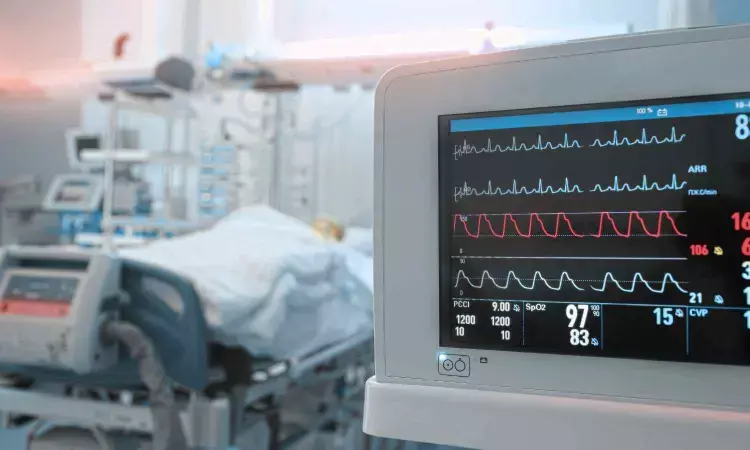- Home
- Medical news & Guidelines
- Anesthesiology
- Cardiology and CTVS
- Critical Care
- Dentistry
- Dermatology
- Diabetes and Endocrinology
- ENT
- Gastroenterology
- Medicine
- Nephrology
- Neurology
- Obstretics-Gynaecology
- Oncology
- Ophthalmology
- Orthopaedics
- Pediatrics-Neonatology
- Psychiatry
- Pulmonology
- Radiology
- Surgery
- Urology
- Laboratory Medicine
- Diet
- Nursing
- Paramedical
- Physiotherapy
- Health news
- Fact Check
- Bone Health Fact Check
- Brain Health Fact Check
- Cancer Related Fact Check
- Child Care Fact Check
- Dental and oral health fact check
- Diabetes and metabolic health fact check
- Diet and Nutrition Fact Check
- Eye and ENT Care Fact Check
- Fitness fact check
- Gut health fact check
- Heart health fact check
- Kidney health fact check
- Medical education fact check
- Men's health fact check
- Respiratory fact check
- Skin and hair care fact check
- Vaccine and Immunization fact check
- Women's health fact check
- AYUSH
- State News
- Andaman and Nicobar Islands
- Andhra Pradesh
- Arunachal Pradesh
- Assam
- Bihar
- Chandigarh
- Chattisgarh
- Dadra and Nagar Haveli
- Daman and Diu
- Delhi
- Goa
- Gujarat
- Haryana
- Himachal Pradesh
- Jammu & Kashmir
- Jharkhand
- Karnataka
- Kerala
- Ladakh
- Lakshadweep
- Madhya Pradesh
- Maharashtra
- Manipur
- Meghalaya
- Mizoram
- Nagaland
- Odisha
- Puducherry
- Punjab
- Rajasthan
- Sikkim
- Tamil Nadu
- Telangana
- Tripura
- Uttar Pradesh
- Uttrakhand
- West Bengal
- Medical Education
- Industry
Data-Driven Decisions: Study Assesses Mortality Risks in ICUs Through Advanced Charting

State-of-the-Art Pediatric Modular OT Opens at Sishu Bhawan, Cuttack
Recent comparative analysis was conducted on various performance monitoring methodologies in intensive care units (ICUs), specifically focusing on standardized mortality ratio (SMR), p-charts, and cumulative sum (CUSUM) charts. The study utilized data from 17 medical-surgical ICUs encompassing 29,592 patients in Ontario, Canada, examining monthly risk-adjusted mortality rates. Positive signals were defined by data points exceeding designated control limits based on the respective methodologies: a 3-sigma limit for p-charts, a 95% confidence interval not encompassing 1 for SMR charts, and an odds ratio greater than 1.5 for CUSUM charts.
Sensitivity Analysis
Through simulation, mortality increases of 10%, 30%, and 50% were applied to ascertain the sensitivity of each method in detecting these increases. Results indicated that CUSUM charts identified 31 signals across 12 different ICUs, while p-charts and SMR detected 21 and 15 signals, respectively. Notably, the p-chart demonstrated the highest sensitivity at 88% for a 50% simulated increase in mortality, contrasted with CUSUM's 71% and SMR's 59%. Lower sensitivity was observed across all methods for smaller increases in mortality.
Operational Advantages
In terms of operational advantage, while CUSUM charts yielded more signals, the p-chart proved simpler for healthcare professionals in interpretation and implementation, enhancing usability in clinical settings. The infographic presentation of signals through small multiples was emphasized as a potent visualization technique for monitoring ICU performance, allowing practitioners to identify trends and patterns effectively. The most critical finding indicated the ineffectiveness of all three methods to detect smaller mortality increases (e.g., 10%), challenging the traditional reliance on SMR, which performed the poorest among the three. The authors proposed the potential of p-charts for real-time monitoring, though emphasized the requirement for an initial period to establish control limits and the need for adopting additional rules that could enhance sensitivity while preserving specificity.
Research Implications
While acknowledging limitations related to signal specificity and the absence of usability testing among clinicians, the study advocates for further exploration of p-charts and their application across additional clinical domains to optimize ICU performance monitoring. Ultimately, the research concludes that p-charts, employed at regular intervals with risk-adjusted mortality data, could serve as valuable instruments for healthcare quality assessment in ICUs.
Key Points
- A comparative analysis was performed on three performance monitoring methodologies—standardized mortality ratio (SMR), p-charts, and cumulative sum (CUSUM) charts—using data from 29,592 patients in 17 medical-surgical ICUs in Ontario, Canada, focusing on monthly risk-adjusted mortality rates.
- Positive signals were defined for each methodology: a 3-sigma limit for p-charts, a 95% confidence interval not encompassing 1 for SMR, and an odds ratio greater than 1.5 for CUSUM, establishing clear criteria for signal detection across the varying methods.
- Sensitivity analyses, involving simulated increases in mortality rates of 10%, 30%, and 50%, revealed that CUSUM charts identified 31 signals in 12 ICUs, while p-charts and SMR detected 21 and 15 signals, respectively, with p-charts demonstrating an 88% sensitivity for a 50% increase in mortality compared to 71% for CUSUM and 59% for SMR.
- Despite CUSUM charts producing a higher number of signals, p-charts were found to be easier to interpret and implement for healthcare professionals, thus potentially increasing usability and efficacy in clinical practice through effective visualization of monitoring signals.
- The findings indicate that none of the methodologies were effective in detecting smaller mortality increases (e.g., 10%), with traditional reliance on SMR being particularly ineffective; this challenges the existing paradigm in performance monitoring.
- The study concludes by endorsing the p-chart method for real-time monitoring of ICU performance, recommending further investigation into its application in other clinical areas, while acknowledging limitations regarding signal specificity and clinician usability testing.
Reference –
Claudio M Martin et al. (2024). Comparison Of Risk-Adjusted Cumulative Quality Control Charts Compared With Standardized Mortality Ratios In Critical Care. *Canadian Journal Of Anaesthesia*, 72, 353 - 363. https://doi.org/10.1007/s12630-024-02863-6.
MBBS, MD (Anaesthesiology), FNB (Cardiac Anaesthesiology)
Dr Monish Raut is a practicing Cardiac Anesthesiologist. He completed his MBBS at Government Medical College, Nagpur, and pursued his MD in Anesthesiology at BJ Medical College, Pune. Further specializing in Cardiac Anesthesiology, Dr Raut earned his FNB in Cardiac Anesthesiology from Sir Ganga Ram Hospital, Delhi.


